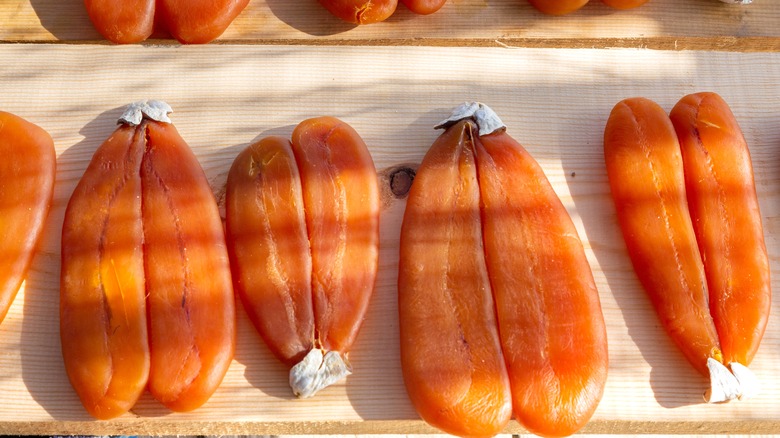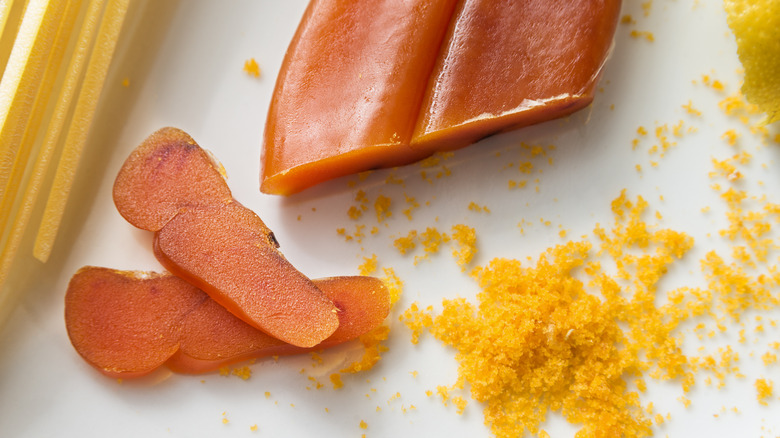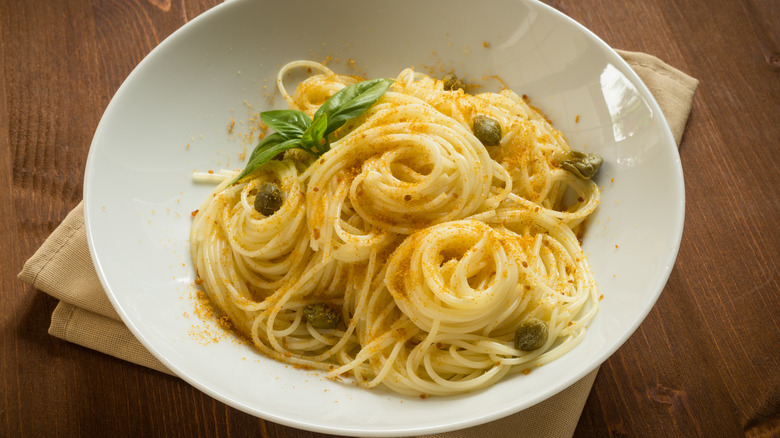What Is Bottarga And How Do You Cook With It?
You may have noticed a recent rise in visibility in a food called bottarga. Suddenly, restaurant menus, cuisine magazines, and foodie websites began shining a light on the expensive, elusive item. At first glance, bottarga looks like it could be several things, including sausage, a block of foie gras, or even some type of dried fruit. In reality, it starts not on land, but under the sea.
Bottarga are basically the roe sacks from fish that are salted, pressed to remove any air, and dried. It is mostly used as a finishing ingredient, being finely grated over savory foods to give them a deep umami and salty kick. It can also be thinly sliced and dressed with oil and lemon juice. Most bottarga comes from grey mullet, but it can also be extracted from halibut, tuna, and a number of other fish. Once dried, it has a long shelf life, allowing you to use it sparingly (as most people do) for months without worrying about it going bad or rancid.
Despite the recent uptick in interest, people have been enjoying bottarga since ancient times. Its nuanced flavor can be described as slightly salty, rich, and, of course, fishy.
A worldwide delicacy
While there's conflicting information on exactly who discovered preserving fish roe, it happened long before the 21st century. There is some belief that the Phoenicians first passed the practice on to 10th century Egyptians or that it originated in the Greek-inhabited Byzantium around 600 B.C.
Eventually, the delicacy was introduced to both the far east and Europe, where it was treated as a very special ingredient, meant to be treasured. There are written accounts praising bottarga from Italy in the Middle Ages and England in the 1600s.
Today, bottarga is popular in many parts of the world, including Japan and China, where it's known as karasumi, and in Korea, which refers to it as eoran. Eoran is cured in soy sauce and brushed with sesame oil. It's eaten in many other countries than these listed, but it's most associated with Italy, where it's imported from Sardinia and Sicily. The familiar orange-colored Italian bottarga comes from grey mullet, but the gray-colored bottarga that comes from Sicilian bluefin tuna is especially desired and prized.
How to cook with bottarga
For starters, you don't actually want to cook bottarga, as that's not how it's meant to be handled. Doing so could affect its firm texture and delicate ocean flavor, two signature elements of this special food.
Sometimes, bottarga is referred to as "poor man's caviar," which is appropriate because it's often used in ways and on dishes where caviar would be used. For instance, a fine grating of bottarga is superb on pasta dishes, over soft-boiled and soft-scrambled eggs, and on top of risotto. Thinly sliced, it's wonderful on top of crostini and on salad. Shower it on top of fried rice or garnish sushi, and place some on top of Danish smørrebrød.
In many parts of Europe and in the Middle East, bottarga is enjoyed at its most simple. It's sliced very thinly, dressed in fresh olive oil, lemon juice, and maybe a bit of garlic and eaten as-is or atop a piece of bread. It's a culinary gem that's meant to be savored. However you use it, make sure nothing overpowers the flavor of this special treat.
Where to find bottarga
Although bottarga is considered a specialty item, similar to caviar and truffles, rest assured that it does not carry the same price tag. In addition, when you consider the shelf life it has, bottarga offers a decent bang for your buck.
That said, you'll have to seek it out at either specialty Italian shops or online purveyors. Pre-grated bottarga is also an option, although many believe it doesn't have the superior taste you'll get when you grate it yourself. Some bottarga comes coated in wax; it needs to be peeled off before you eat it.
Storing bottarga couldn't be easier once you start to use it. After use, simply wrap the remaining portion tightly in plastic and store it in the refrigerator. Because it's been cured and dried, it will last for an incredibly long time, allowing you to use it at your discretion without concern of it going bad. You'll be amazed at how bottarga will turn your simplest meals into ones that taste extraordinarily special.




